Air Conditioning at the Movies - Staying Cool at a Theater Near You
Published by Reblogs - Credits in Posts,
Excessive heat warning!
Coast to coast heat scorches!
You cannot escape the headlines about the record-breaking heat waves plaguing the country and the world. This has me thinking about air conditioning, thankful for the unit I purchased right before the mercury spiked. Imagine living in a world or a place without this necessity. Like it was everywhere before the air conditioner was invented or before people could afford them.
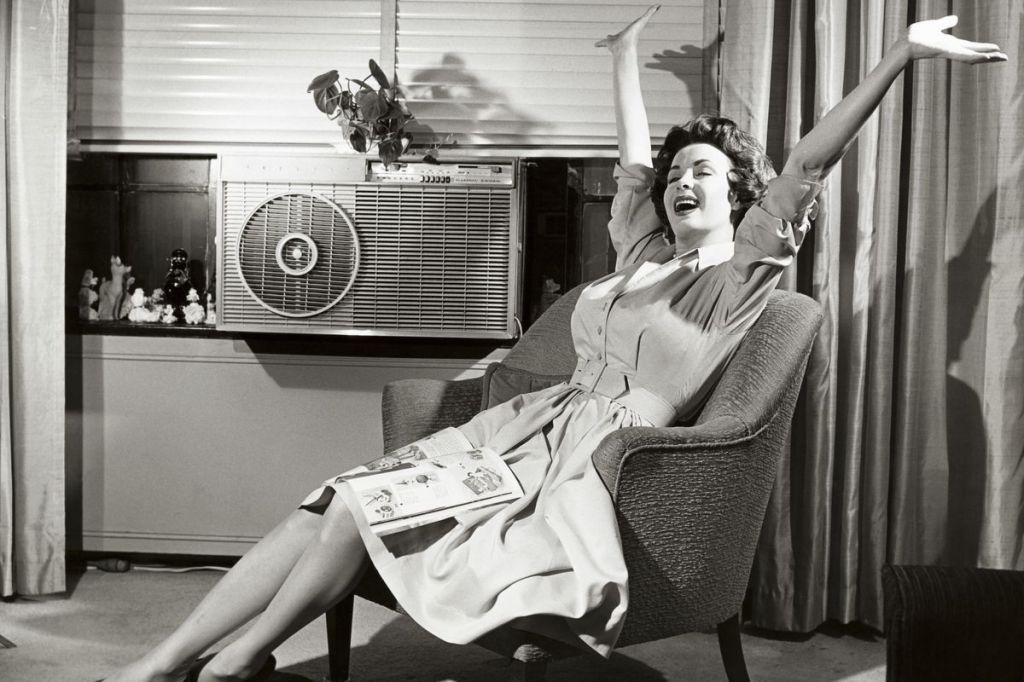
According to the National Weather Service, the worst heat wave ever in the United States happened in 1936. That year still holds several heat-related records. While most of us take air conditioning for granted today with nearly 90% of American households using air conditioning, there was a time when they were a luxury few could afford. For instance, inventors H.H. Schultz and J.Q. Sherman filed the patent for air conditioning units that could be placed on window ledges in 1931, but people were reeling from the effects of the Great Depression and could hardly afford food. Forget about staying cool at home. It was widespread practice to sleep outside overnight or wet bedsheets in cold water to help alleviate the heat. What little entertainment they could afford happened in movie theaters, which brings us to the story of staying cool at the movies.
We know that entertainment has played a vital role in all manner of cultural advances and trends so it should be no surprise that it also played a key role in the development of air conditioning. If you cannot get an audience to watch a performance you are not making any money and for early owners overcrowded and overheated theaters were a major problem.
Consider this…Thomas Edison’s first Vitascope screening took place in 1896 and the opening of many small theaters soon followed. A Pittsburgh theater operator took the name, Nickelodeon in 1905 and before you knew it there were an estimated 8,000 theaters across the country. Millions were entertained by the movies, but the experience was oppressive. Although the first public comfort cooling demonstration had taken place at the St. Louis World’s Fair in 1904, early movie theaters were nowhere near that advancement. Theaters usually had no windows. Owners often suffered a steep downturn in ticket sales during the summer months or they closed theaters altogether. Paper or folding fans were necessary. Imagine trying to pay attention to images on a screen with a constant flurry of fluttering fans surrounding you. Also, if you went to the movies on a date I bet all glamour was out the window. Oh wait, no windows. Well, I can guarantee few looked like Myrna Loy after using folding fans in between beads of sweat.
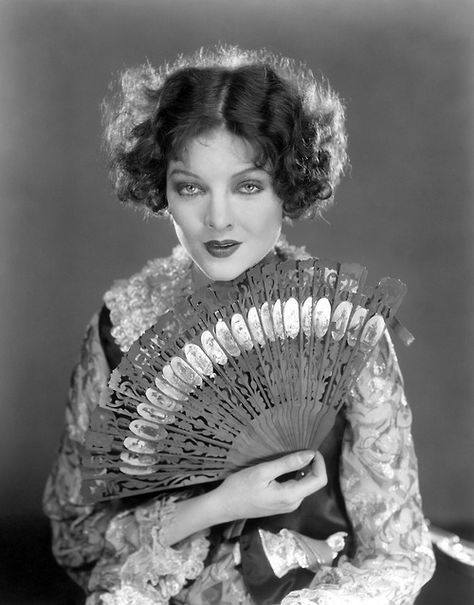
Myrna Loy for Roy Del Ruth’s The Desert Song (1929)
Despite the difficulties, movies and theaters grew and developed into features and opulent movie houses in the 1910s and 1920s. Theaters experimented with several popular cooling systems. Some used systems that brought air into the theater from outside forcing the hot air out. Except the air outside was also hot. Other theaters used fans to remove hot air from the space with lobby doors open leaving the theatergoers in the back to suffer the ambient heat. Still other theaters stored blocks of ice in the basement and used fans to circulate that cooled air throughout theaters. One can imagine how often the ice had to be replaced. In short, none of those systems were effective or comfortable. Everybody involved in movies knew that the air needed to be cooled. Circulating hot air would not bring moviegoers into theaters. But if the air were cooled, they would come often and stay long. Unless of course the blob threatened to swallow them.
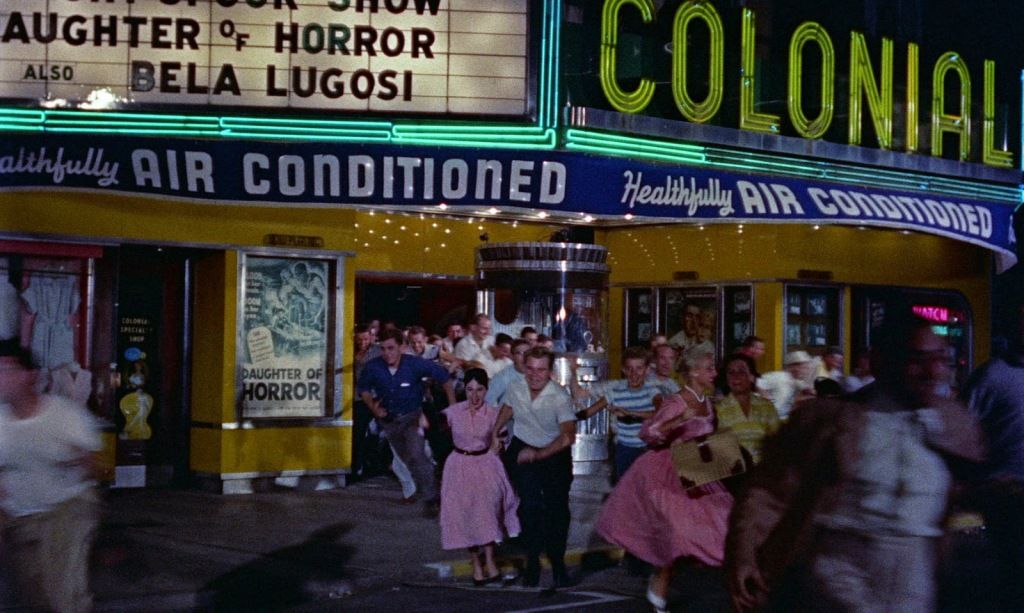
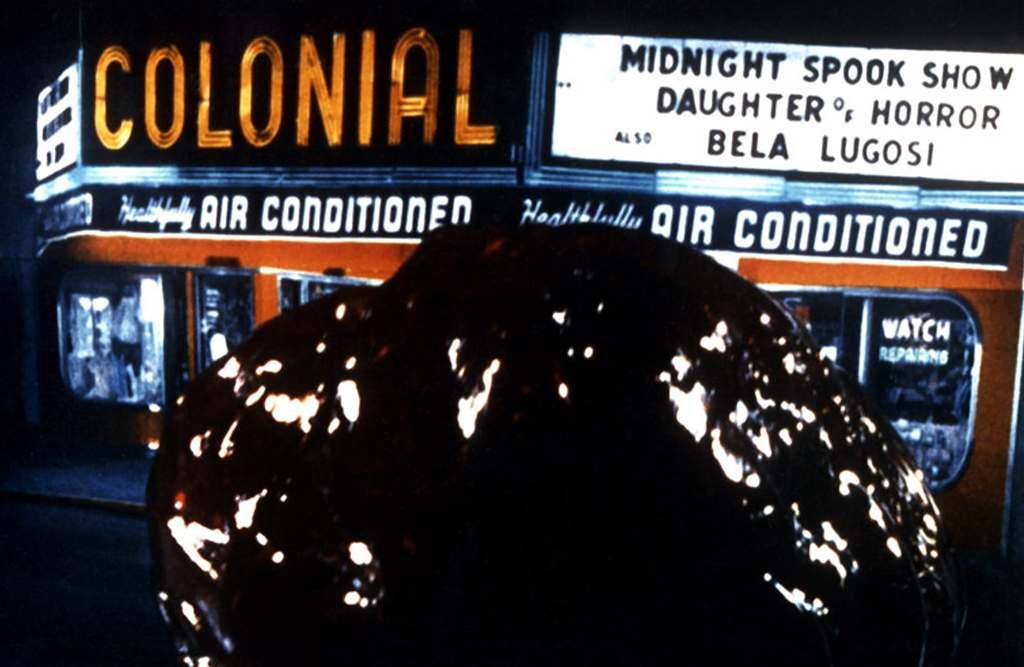
Taking a step back a moment to 1902 when the Sackett-Wilhems Lithographic and Publishing Company in Brooklyn New York needed to find a way to reduce the humidity inside its plant. The humidity was affecting the output because it caused the paper size to change which caused havoc with alignment. Sackett-Wilhems sought help from the Buffalo Forge Company where 25-year-old engineer Willis Carrier worked. Carrier was given the task of finding a solution to the moisture issue at the printing plant, which he did and then some. Not only did Carrier produce a machine that removed moisture from the air, but it also cooled the air inside the plant. Carrier’s invention became the first air conditioner used in July 1902. Although the term "air conditioning" was not coined until 1906 by another inventor, Stuart W. Cramer of North Carolina. Carrier’s solution to the problem of humidity control was patented as an "Apparatus for Treating Air."
While others were experimenting with the development of cooling systems at the same time as Willis Carrier, he remained central to the development. "After refining his installation at the Sackett-Wilhelms printing plant in the spring of 1903, Carrier introduced similar devices to a variety of other industries—a Johnny Icicle planting the seeds of climate control across America. He air-conditioned the first paper mill in New York in 1906; the first pharmaceutical plant in Detroit in 1907; the first celluloid-film plant in New Jersey in 1908; the first tobacco warehouse in Kentucky in 1909; the first candy-manufacturing establishment in Milwaukee in 1910; and the first bakery in Buffalo in 1911." (American Heritage)
Word about Willis Carrier’s new machine spread quickly, which would revolutionize productivity across manufacturing and, for our purposes, change the future of the movies.
As with any innovation, air conditioning in movie theaters improved over time and in various places. One example happened in 1917 Chicago where the first full air conditioning system with mechanical refrigeration was installed in the Balaban & Katz Central Park Theatre. This was the first theater to have mechanical cool air. The Balaban & Katz theater chain was small at the time but grew to compete with the big chains thanks to its cooling system. Ensuring the comfort of the public became an important consideration in attracting people in hot and humid weather. Other independent theater chains were burgeoning as well competing with the big five – Warner Bros Pictures, Paramount, RKO (Radio-Keith-Orpheum) Pictures, Loew’s Incorporated (which became Metro-Goldwyn-Mayer) and Fox Film Corporation. The three smaller, but important, studios were Universal Pictures, United Artists, and Columbia Pictures. Just as theater chains gained momentum, so did companies that provided cooling systems to theaters competing with Carrier.
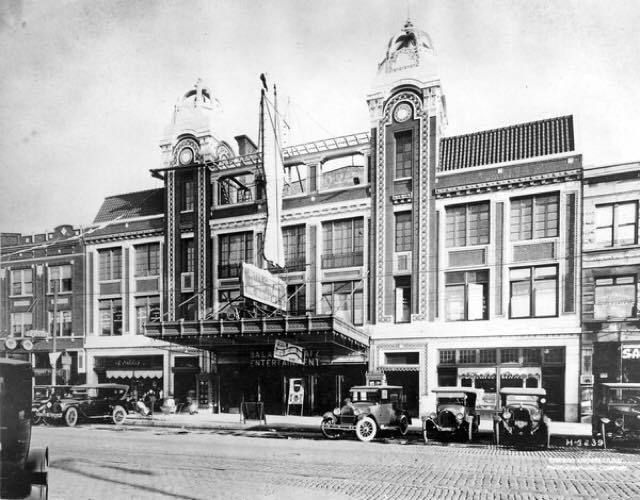
The First Air-Conditioned Theater in the U.S. was the Central Park Theater in Chicago, which opened in 1917 at 3535 W. Roosevelt Road.
Fast forward to 1922, which proved an important year for theaters across the country with the unveiling of a compressor that allowed smaller theaters to compete with the palaces. There is no way for me to understand or explain the intricacies of air conditioning systems, but I do understand that prior to 1922 only a 3,000—seat movie palace could afford the cost of the huge cooling system that existed. The Carrier Engineering Corporation installed the first ‘modern’ cooling system for theaters at the Grauman’s Metropolitan Theater in Los Angeles. This system pumped cool air through high vents to control humidity throughout the building. The installation at Grauman’s Metropolitan is considered by many the birthplace of theater air conditioning even though updated systems were being installed in other cities as early as 1924 – following the Chicago installation. This article explains how air conditioners made it into Baltimore theaters for example. The real test came three years later at the Rivoli Theater in New York, however, "until the new system played on Broadway, it could not really be considered a success."
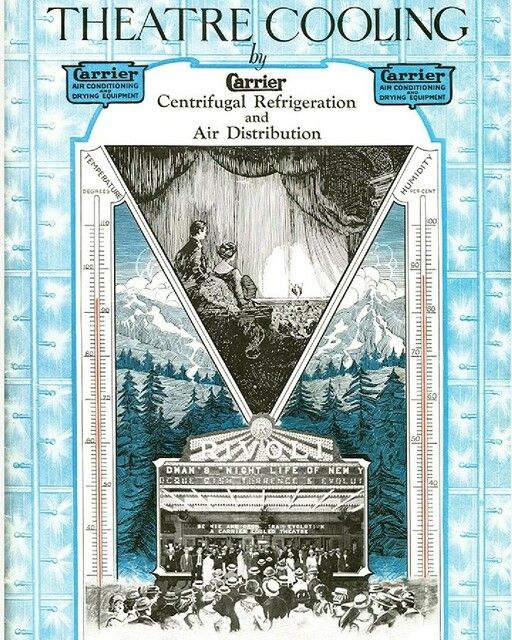
1925 Carrier ad used at the Rivoli
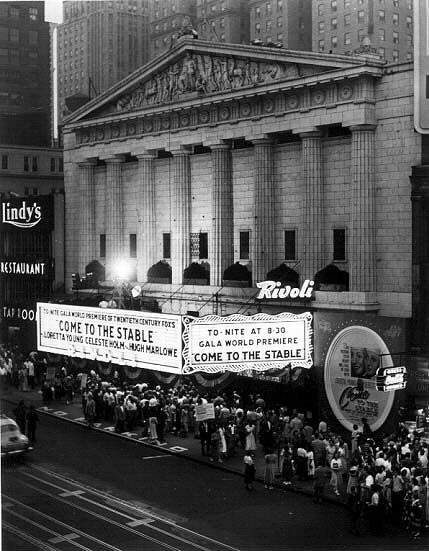
New York’s Rivoli Theatre in 1949
In 1925 a more refined Carrier system was introduced at New York’s Rivoli Theatre and this would revolutionize "man-made weather" and the moviegoing experience. The Rivoli opened with the Carrier system on Memorial Day with box office receipts increasing instantly by $5,000 a week. People lined up at the box office long before the doors opened. "It was like a World Series crowd waiting for bleacher seats," Willis Carrier wrote in a memorandum after the event. "They were not only curious, but skeptical—all of the women and some of the men had fans…." Among those in attendance was Adolph Zukor, head of Paramount Pictures, who had come from California to observe the new system firsthand. "Yes, the people are going to like it," Zukor said that first day. The Carrier Corp. stated that was when "The world started to become aware of air-conditioned theaters." (ACHR.News) Though all businesses were paying attention.
Over the next five years Carrier installed air conditioning systems in about three hundred theaters in the United States with more added every year thereafter. Eager to advertise theaters hung banners from their marquees that read "Cooled by Refrigeration" or "ice-conditioned" or any variation. The movie industry became the leader in promoting and practicing mass cool comfort.

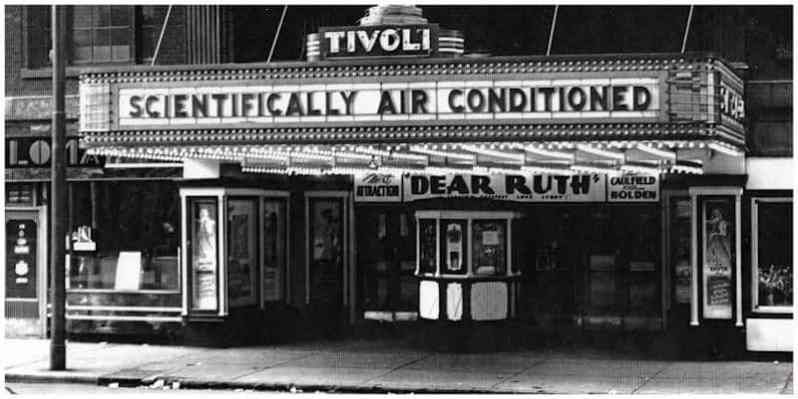
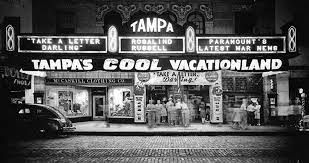
 Movie Theaters, lobbycard, The Garden Theater, ticket booth, and posters for DR. NO, and FROM RUSSIA WITH LOVE, constructed in 1927. (Photo by LMPC via Getty Images)
Movie Theaters, lobbycard, The Garden Theater, ticket booth, and posters for DR. NO, and FROM RUSSIA WITH LOVE, constructed in 1927. (Photo by LMPC via Getty Images)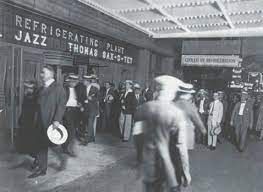
 View of the lobby of the Palace Theater, located on Cincinnati’s 6th and Vine Streets, 1930. Various signs tout the newly installed air conditioning while the marquee advertises the movie ‘True to the Navy’, starring Clara Bow. (Photo by Cincinnati Museum Center/Getty Images)
View of the lobby of the Palace Theater, located on Cincinnati’s 6th and Vine Streets, 1930. Various signs tout the newly installed air conditioning while the marquee advertises the movie ‘True to the Navy’, starring Clara Bow. (Photo by Cincinnati Museum Center/Getty Images)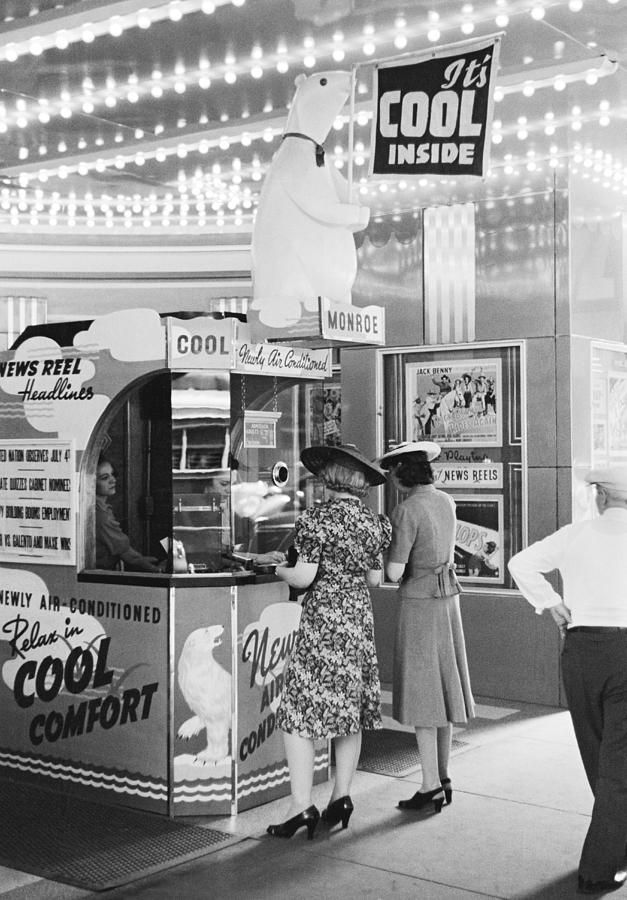
 circa 1925: A burlesque theater advertises its Frigidaire air conditioning, which first appeared in theaters in the 1920s. (Photo by Hulton Archive/Getty Images)
circa 1925: A burlesque theater advertises its Frigidaire air conditioning, which first appeared in theaters in the 1920s. (Photo by Hulton Archive/Getty Images)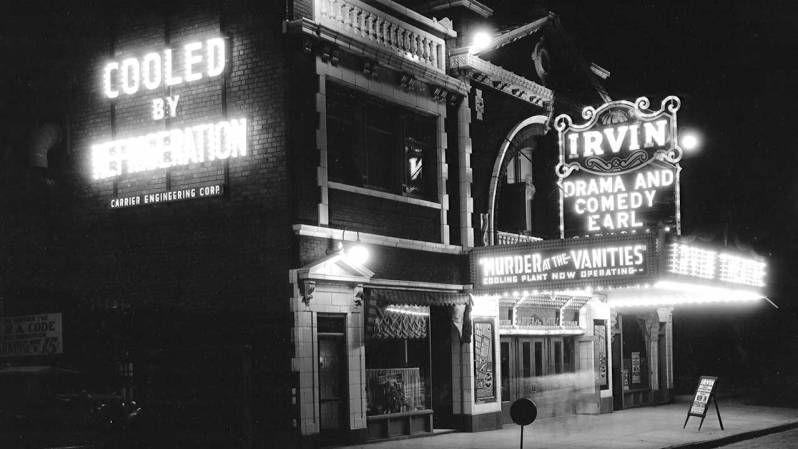
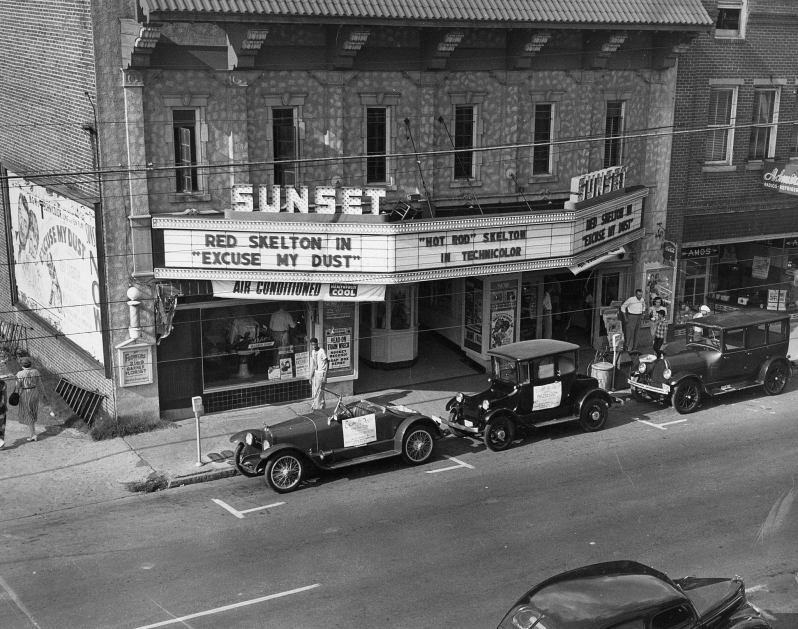
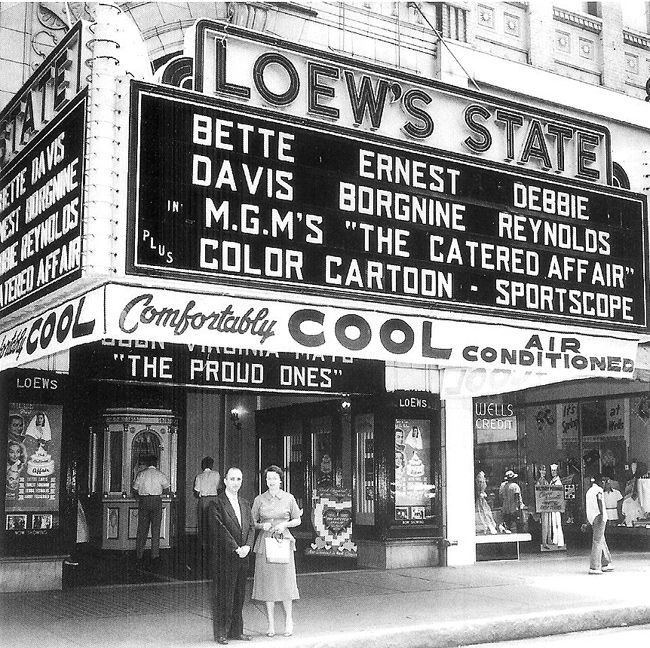

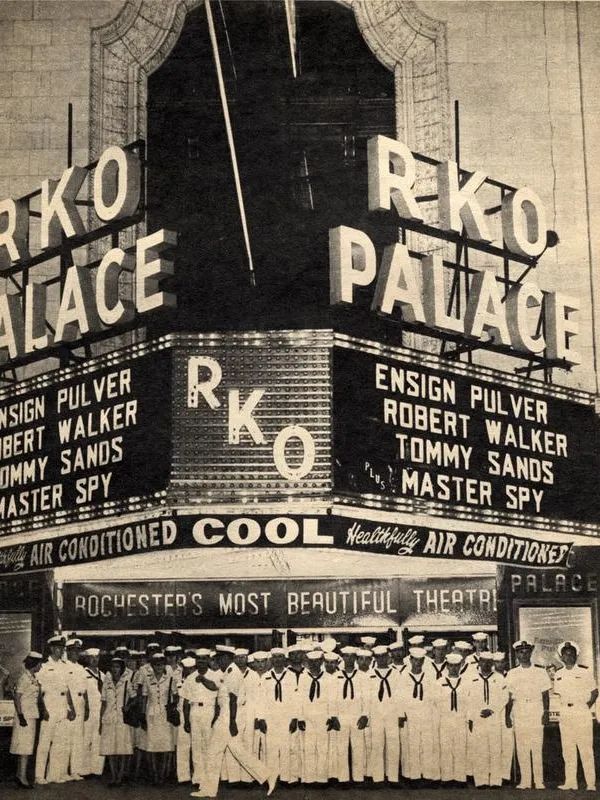
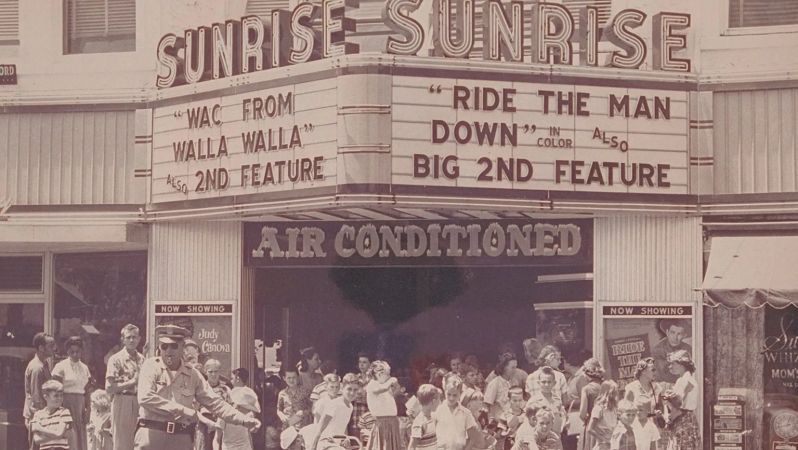
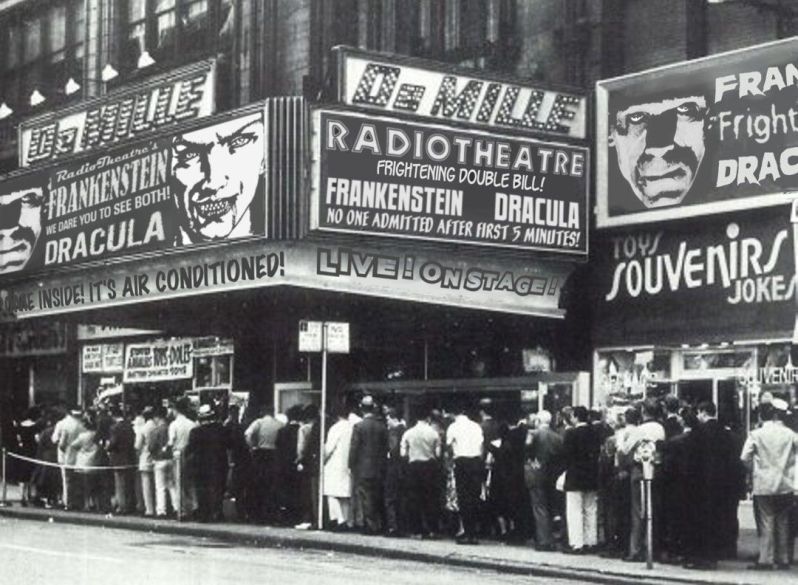
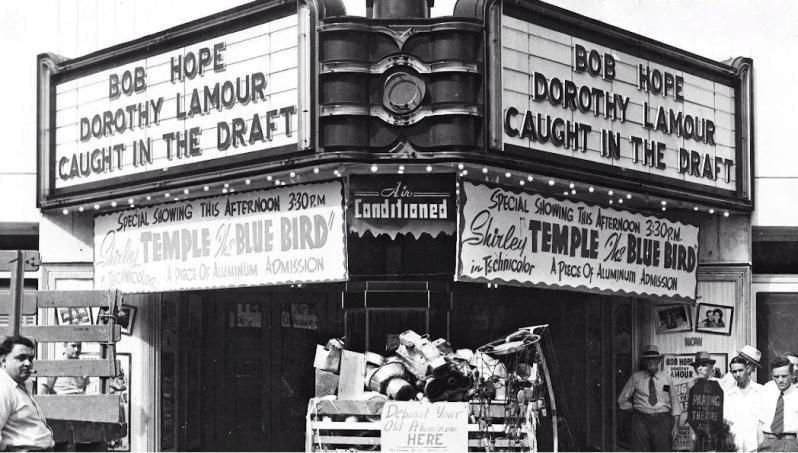

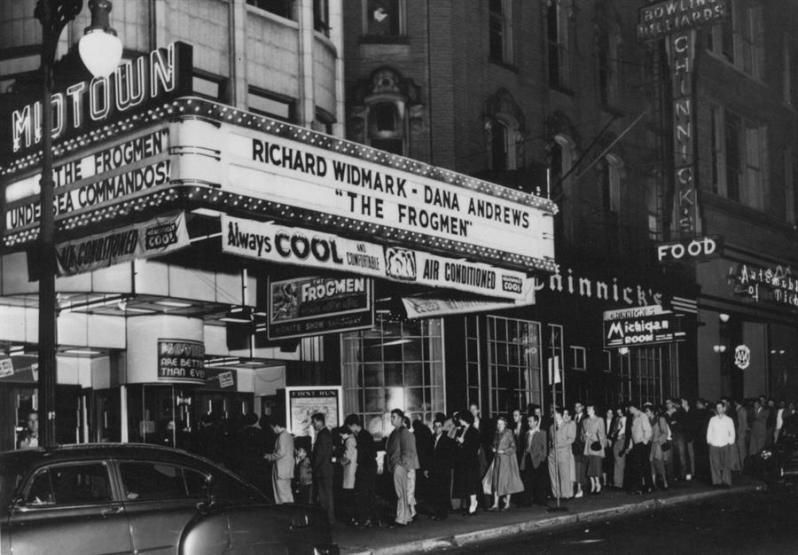
 1935 PHOTO OF METROPOLITAN THEATER. air conditioned theater
1935 PHOTO OF METROPOLITAN THEATER. air conditioned theater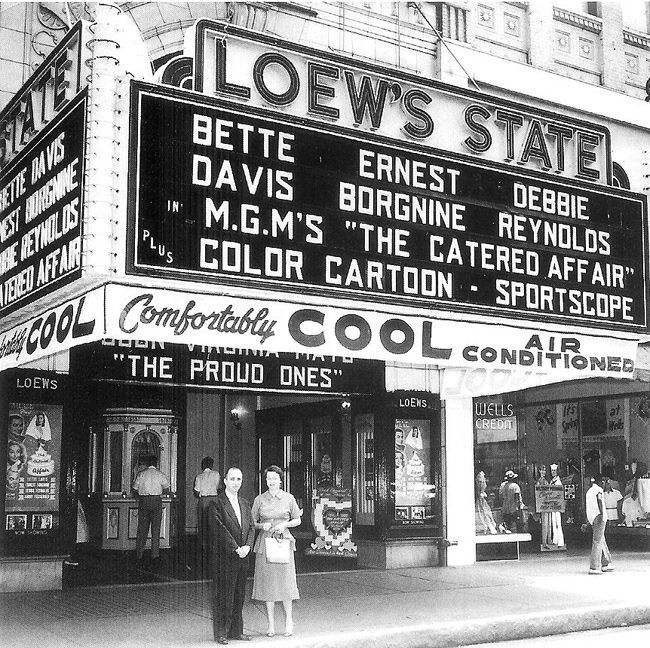
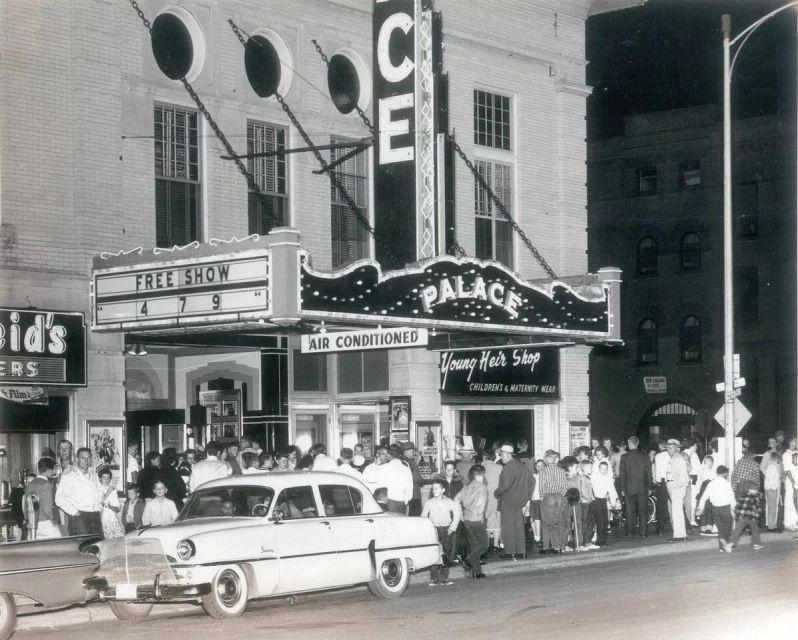
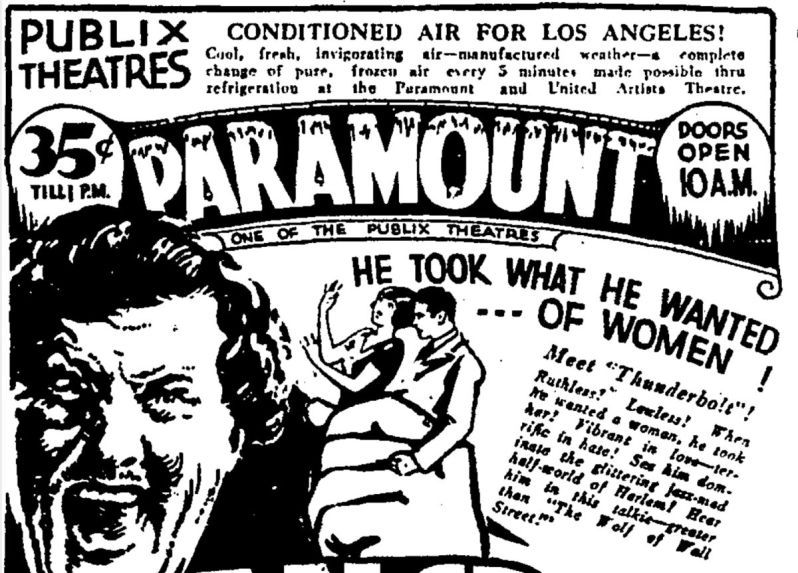
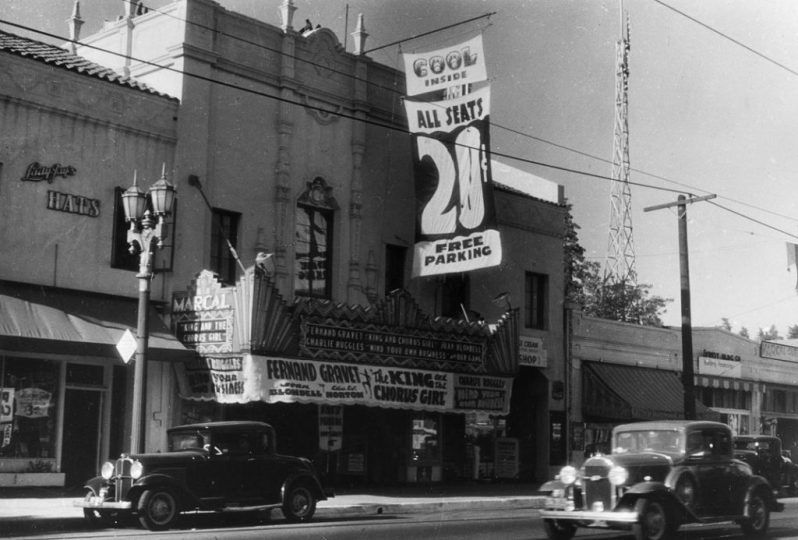
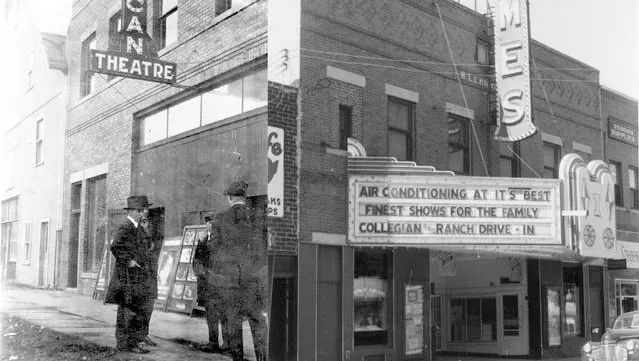
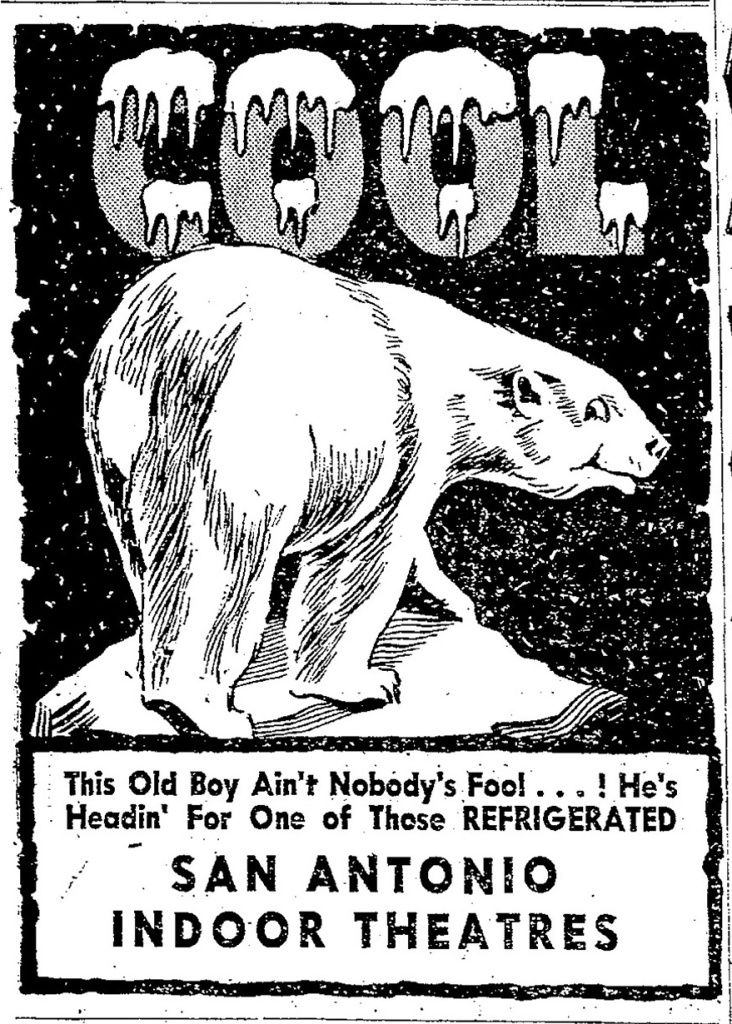
It is no coincidence that while air conditioning was becoming common place in movie theaters that the era was one of prosperity for the industry. Between 1922 and 1930, total investment in the industry leaped from $78 to $850 million. The average weekly attendance at American movie theaters doubled from 1922 (40 million) to 1928 (80 million). Central to the industry’s expansion was a strategy of buying and building movie theaters. (WorldHistoryBiz)
Thanks to air conditioning the summer months, which all but assured losses, became the movie industry’s most profitable season of the year. The summer blockbuster would not exist if not for the air conditioner and perhaps even talking pictures. Due to air conditioning systems movie studios could keep doors and windows closed, eliminating outside noise while keeping actors and other personnel cool. A 2001 article by John R. Hall, 1930s Bring A/C Into the Mainstream in ACHR News mentions the following fun facts:
- In late 1938, Walt Disney announced that he was giving the OK to air condition the new studios of Walt Disney Enterprises, Inc. In addition to the comfort of the eight hundred workers in the 20-plus buildings, the control of humidity was "highly important" in the processes of inking and painting on celluloid — the method of creating cartoons.
- In February 1939, it was reported that air conditioned "love scenes" were the newest boon to better motion pictures.
- That same year director Edwin Marin tried to find the best air-conditioned sets for his stars, to make them more comfortable under the hot lights. For example, Robert Montgomery and Rosalind Russell had a stage temperature of 67°F while filming their funny, romantic scenes from Fast and Loose. Greta Garbo liked a stage temperature of 65°, while Joan Crawford and Myrna Loy usually preferred 70° temperatures.
The history of air conditioning in movie theaters noted here is a shortened version. Not mentioned, for instance, are the snags the air conditioning industry encountered along the way to cooling mass audiences. It is also important to note that while movie theaters packed records crowds into their newly cooled auditoriums, most other types of business also flourished. Improvements in the quality of air also aided in healthcare and healthier lifestyles. Still, the role movie theaters played in the public’s love affair with the air conditioner cannot be underplayed. It was in movie palaces that many were introduced to cool air, and it is no coincidence that cool air arrived as the golden age of Hollywood did. In short, air conditioning has had dramatic impact on the quality of life in America and around the world.
The world and our country are different places than they were a century ago. Movie Palaces have been replaced by multiplexes where you get less for more and theaters do not play the prominent role in people’s lives they once did. Most important of all is the fact that air conditioning is standard. In fact, we mostly take it for granted. Or are we asking, why are movie theaters so cold? I have been known to take a sweater when I go to the movies. Even in Miami, Florida. No complaints though. I’m pretty sure we are all grateful to Willis Carrier and everyone else who for making air conditioners part of our lives.
Until next time stay cool, watch movies and hydrate.
I had a bit of fun with this, but heat waves are serious business during which people get hurt. It is especially dangerous for the elderly. Here are tips on what to do during heat waves from the Red Cross. Also, mind your neighbors.
Extras:
1941 Carrier Promotional Film, Weather by Carrier: The Story of Air Conditioning…
From Movies Silently, Five Ice Cold Silent Films to Cool Your Summer
From Bon Appétit, A History of Movie Theater Snacks in America
NYTimes article, Celebrating the 30’s, When Nearly Everyone Went to the Movies
References:
